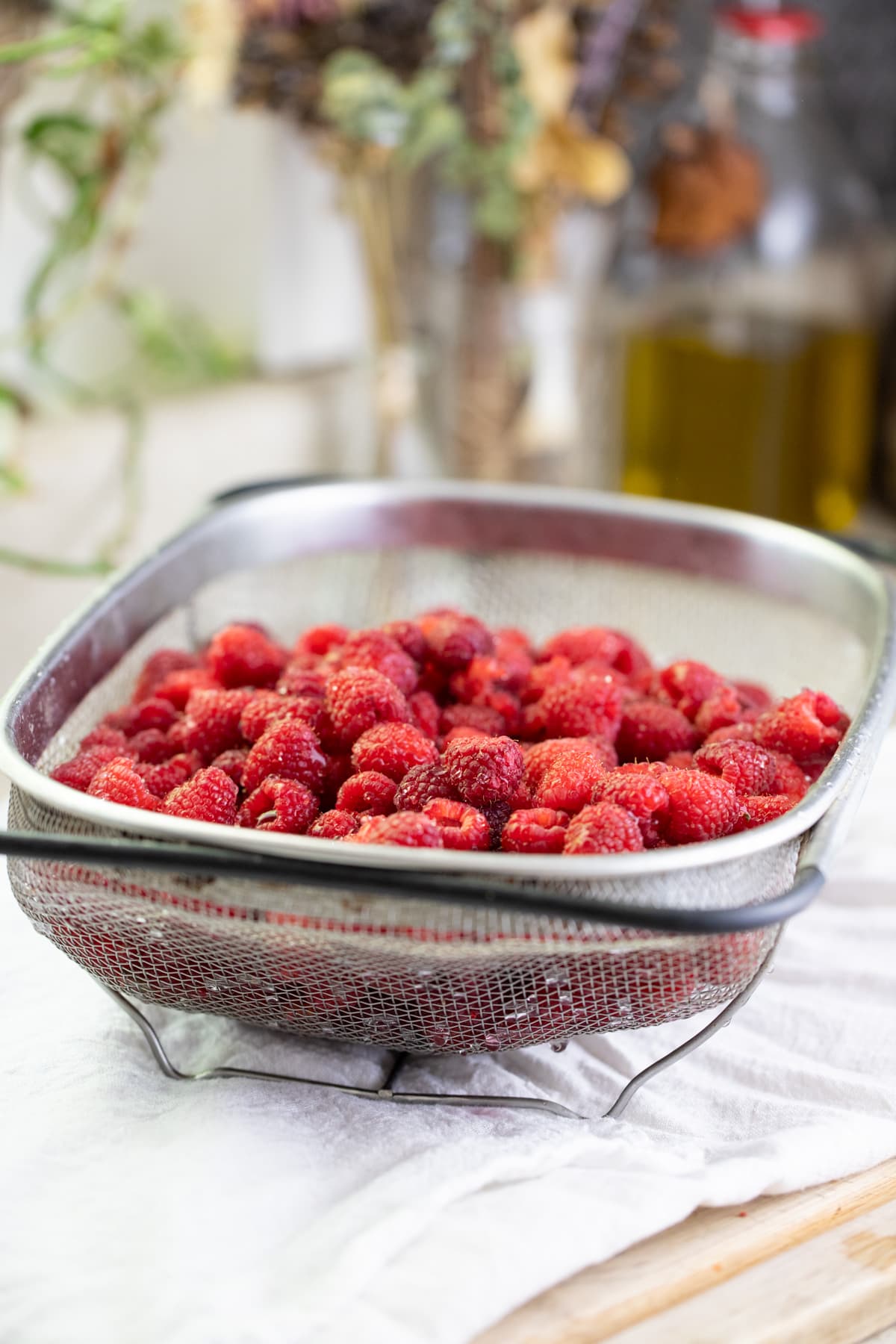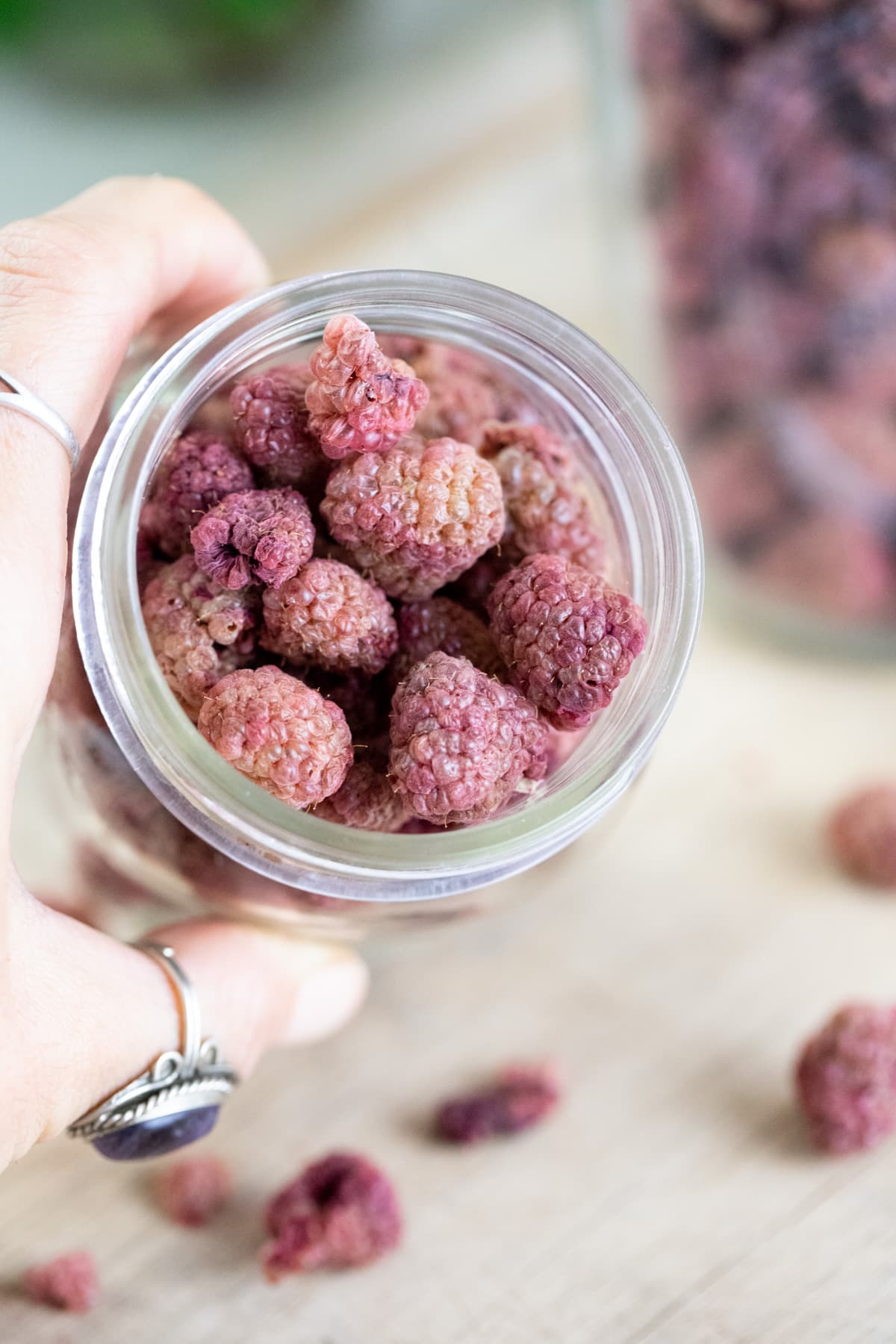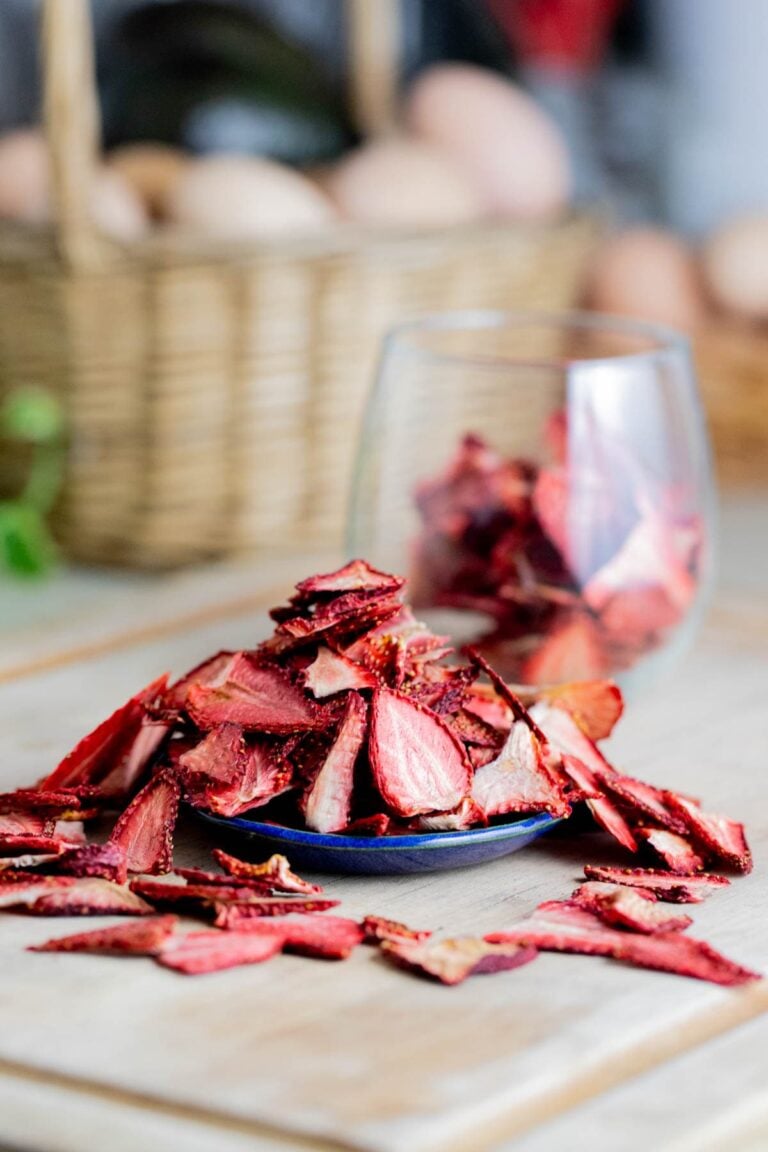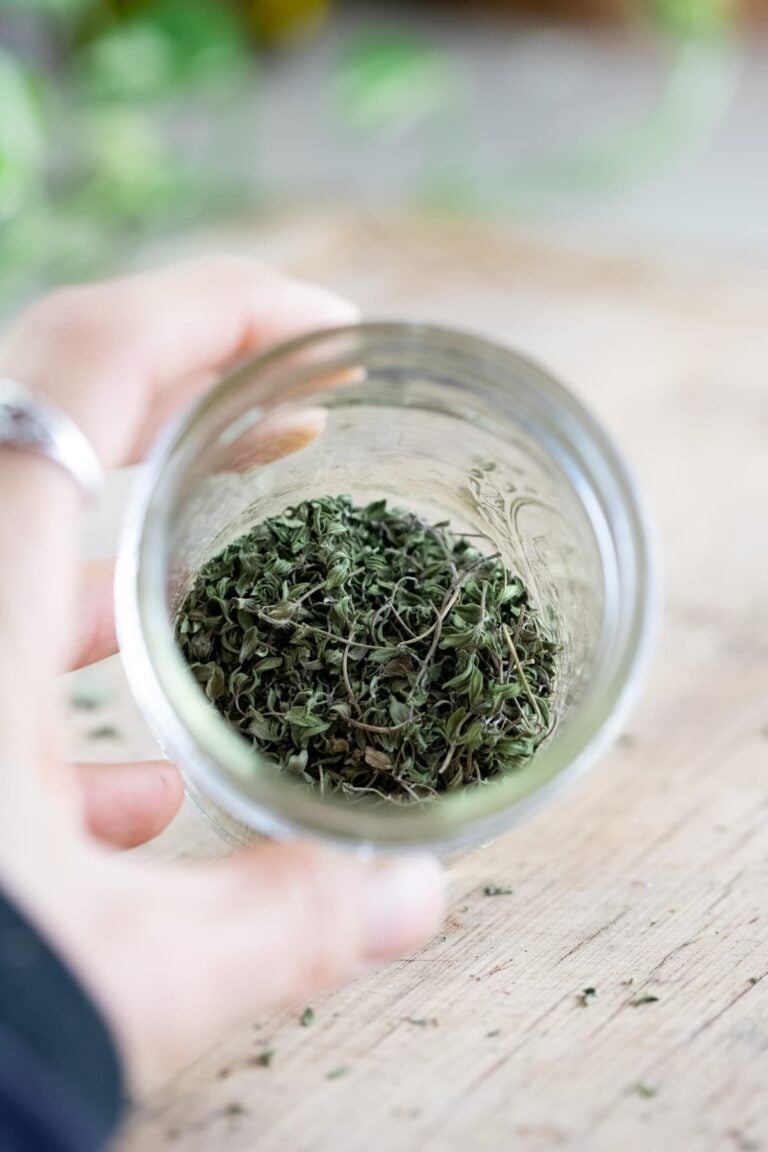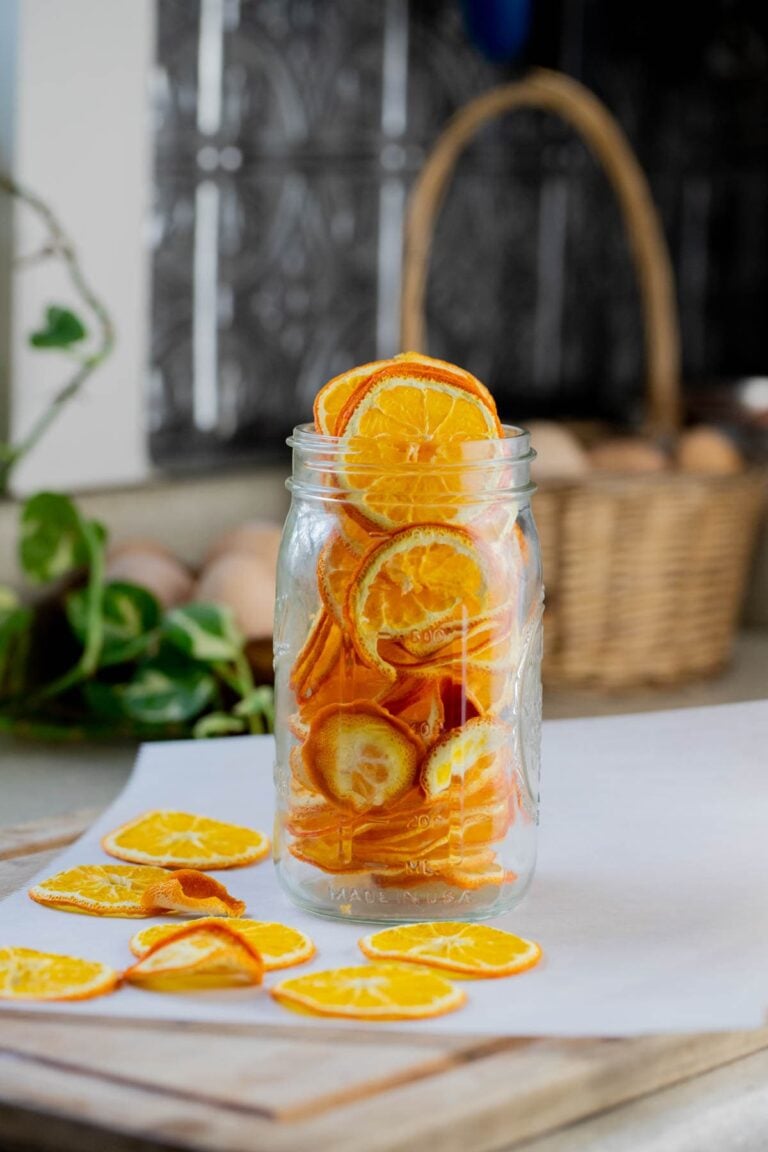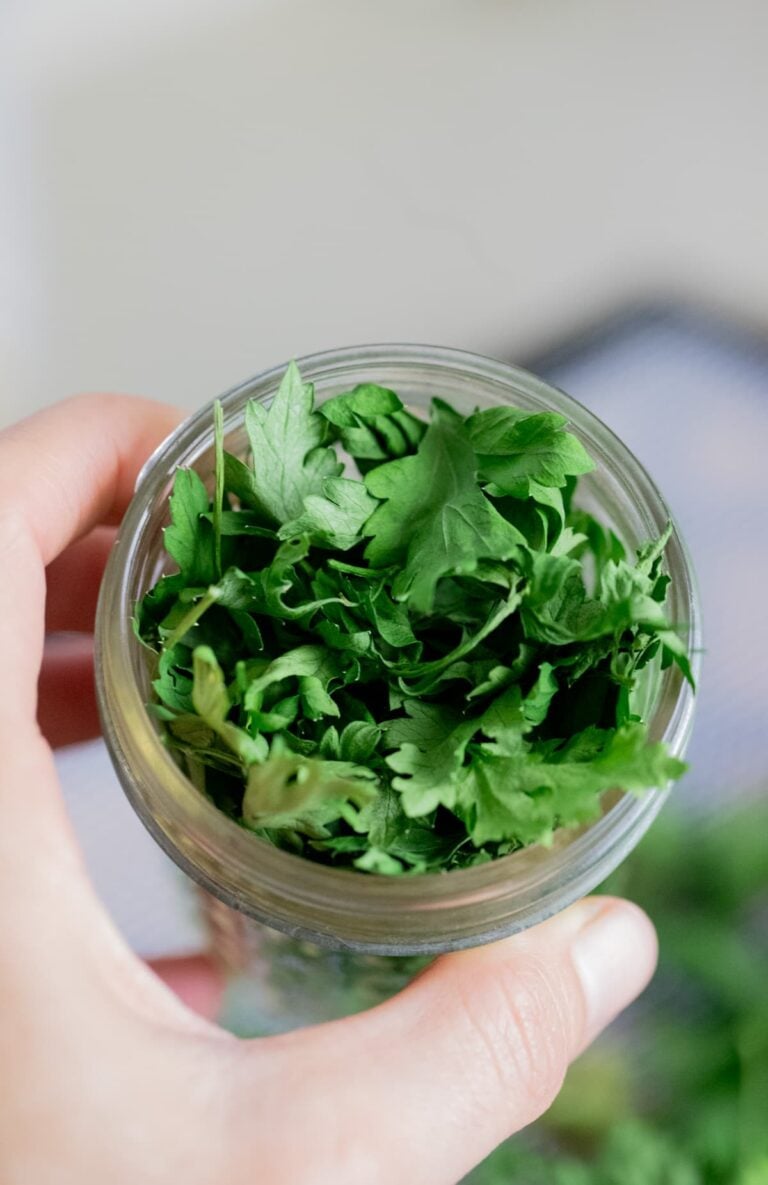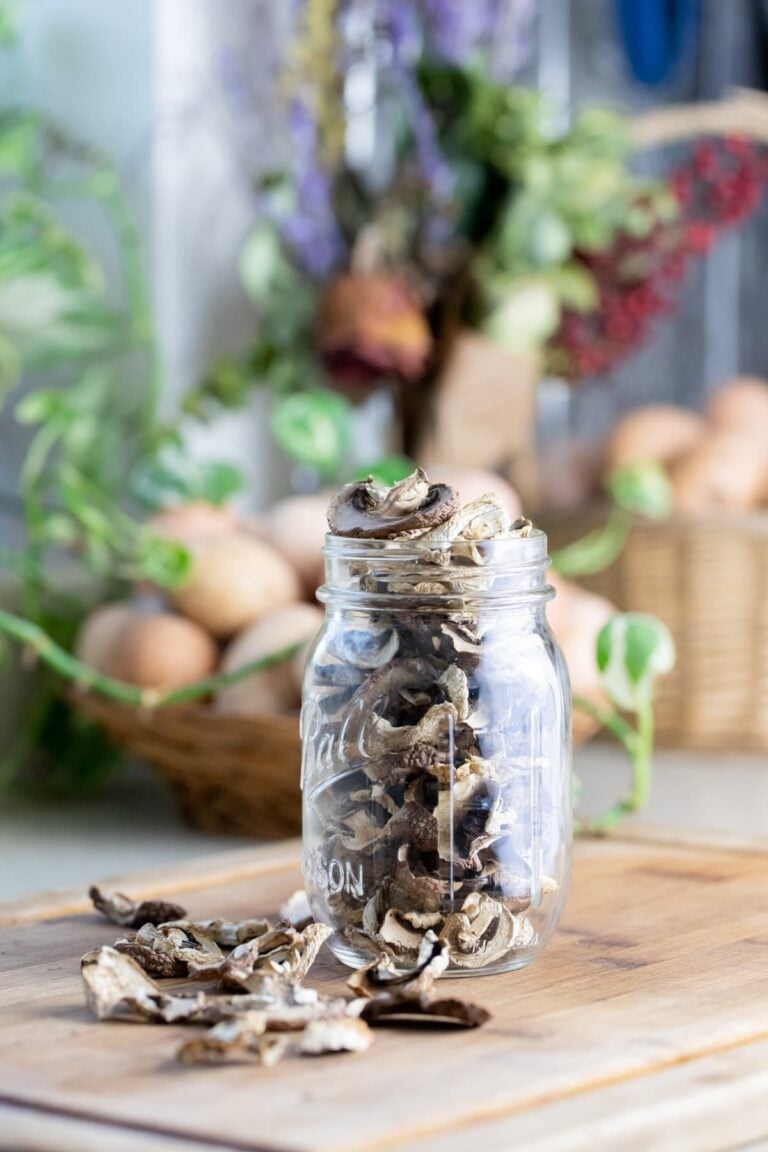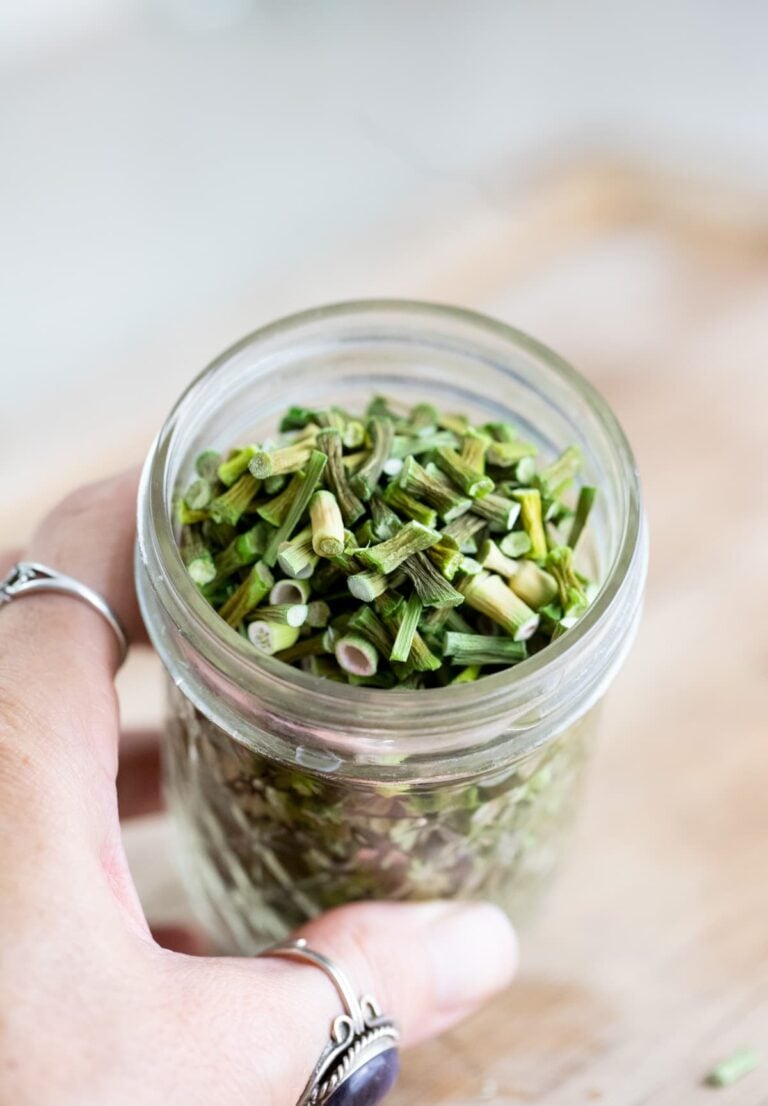Dehydrating Raspberries
This post may contain affiliate links, view our disclosure policy for details.
Dehydrating raspberries is very easy! There is pretty much no prep work and the result is a tasty, fun, and healthy snack that is very easy to grab and enjoy.
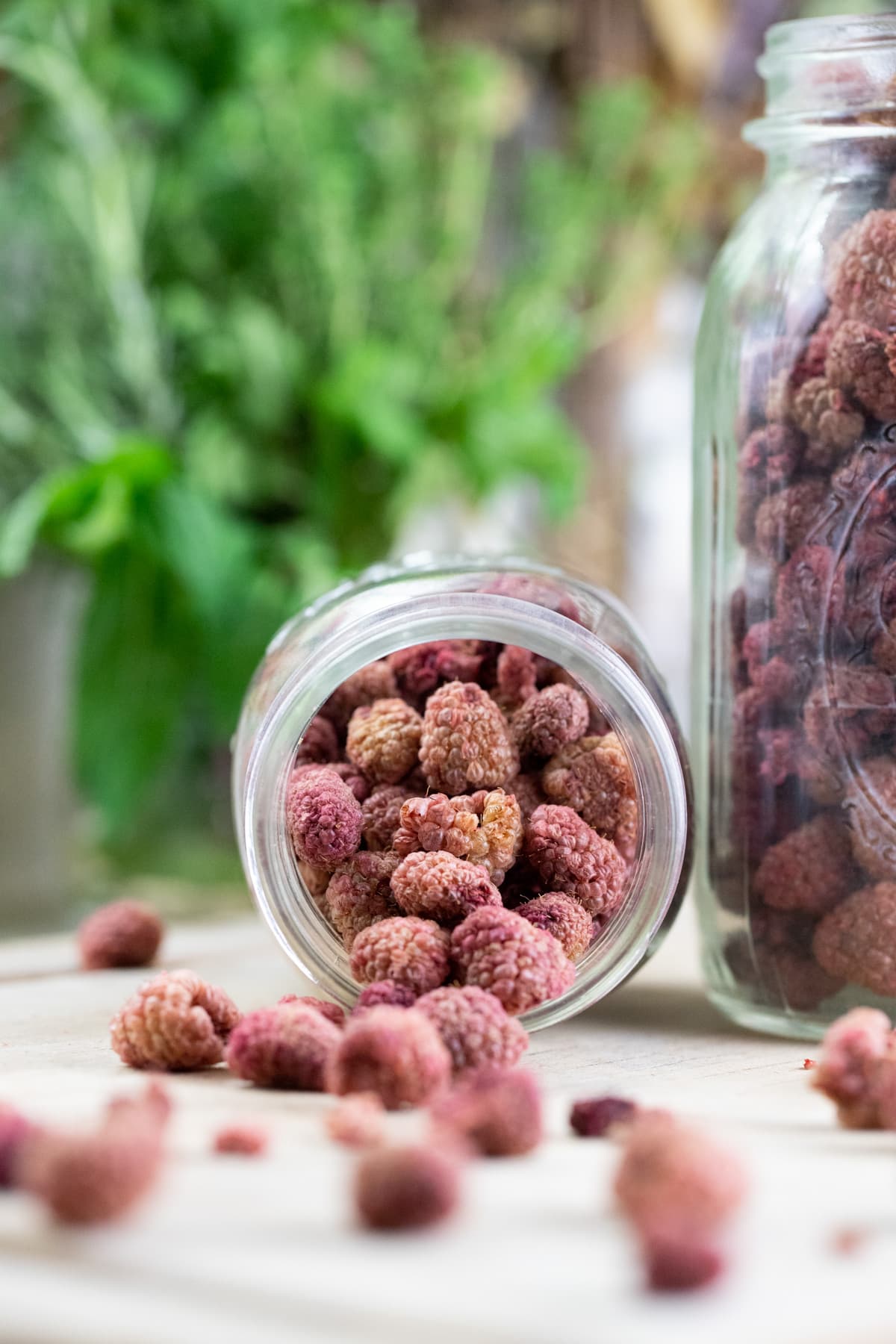
Lady Lee’s Note…
I don’t grow raspberries… yet. This yummy fruit is definitely on my list. We all love raspberries. They aren’t too sweet, they are fun to eat fresh, and they are fun to use in baked goods.
We can find them easily in our area every summer. I often can find them at the market or we usually have a friend or two that will invite us to come and pick raspberries. We love enjoying them fresh, but I often try to preserve some for later as well.
Canning raspberries is easy enough, freezing them is very easy as well, and drying them is just as easy as the other two options, if not easier. What I love about dehydrating raspberries is that we can turn some of them into raspberry powder which is a whole different ingredient that we can use in many different ways.
Reasons For Drying Raspberries…
- Preserving the flavor – berries in the season taste very different than berries not in season! I love preserving fruit when it’s at its best.
- Another way to eat them – I know it’s hard to believe, but during the spring and summer, sometimes we are just sick of eating fresh berries. It’s a rare occasion but it does happen once in a while, so changing things up a bit and dehydrating the fruit gives us just another fun, yet different way to enjoy it.
- Easy to travel with – dehydrated raspberries are a great hiking/camping/picnicking snack. They are easy to pack in a jar or a zip-lock bag and take with you anywhere you go.
- Preserving for long-term storage – I don’t grow raspberries yet, but I can often find them for a very good price during the summer. I love to take advantage of this, purchase a lot of them and preserve them for later.
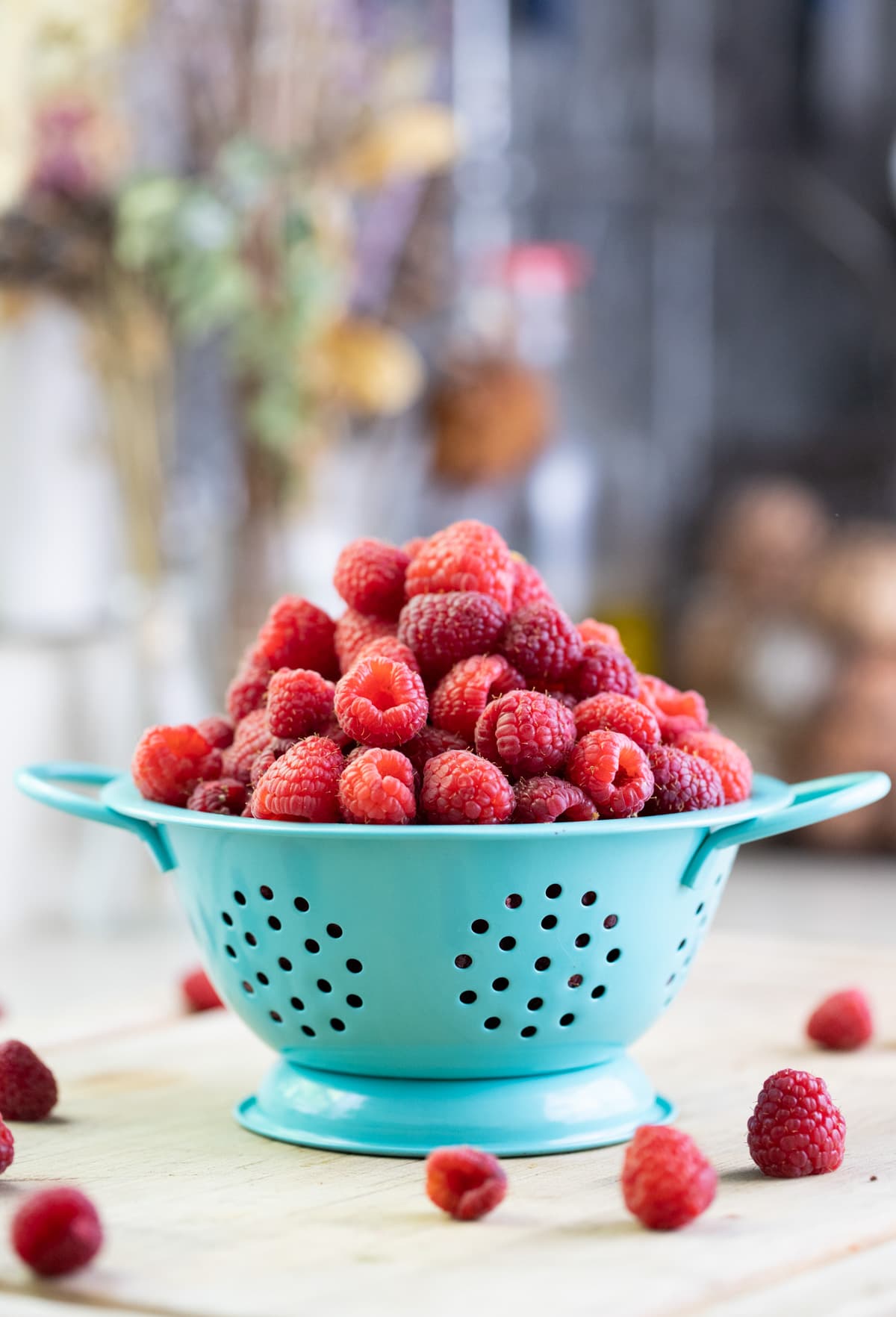
Ingredients…
- Raspberries – that’s all you need! Make sure that you are choosing ripe yet not too ripe fruit. I used 54 ounces of raspberries in this tutorial, but you can process however many you’d like.
- Seasonings – it’s possible to add some cinnamon or maybe sugar on top of your berries before you dehydrate them. More on this in the FAQ section below. I’ll keep it simple in the tutorial below and will only use raspberries.
Kitchen Tools…
- Colander
- Dehydrator – I am using a nice dehydrator that allows me to control the temperature and produces a better end result. If you don’t have one of those, you can still dehydrate raspberries in the oven or in a cheap (no temperature control) dehydrator. More on this in the FAQ section below.
- Air tight storage container (I use jars)
Step By Step Instructions…
Step one – prep the raspberries. If you need to, place the raspberries in a colander and wash the fruit. Then go over it and remove any moldy or rotten berries. Let the berries dry for a few minutes. You can also place them on a kitchen towel and pat them dry.
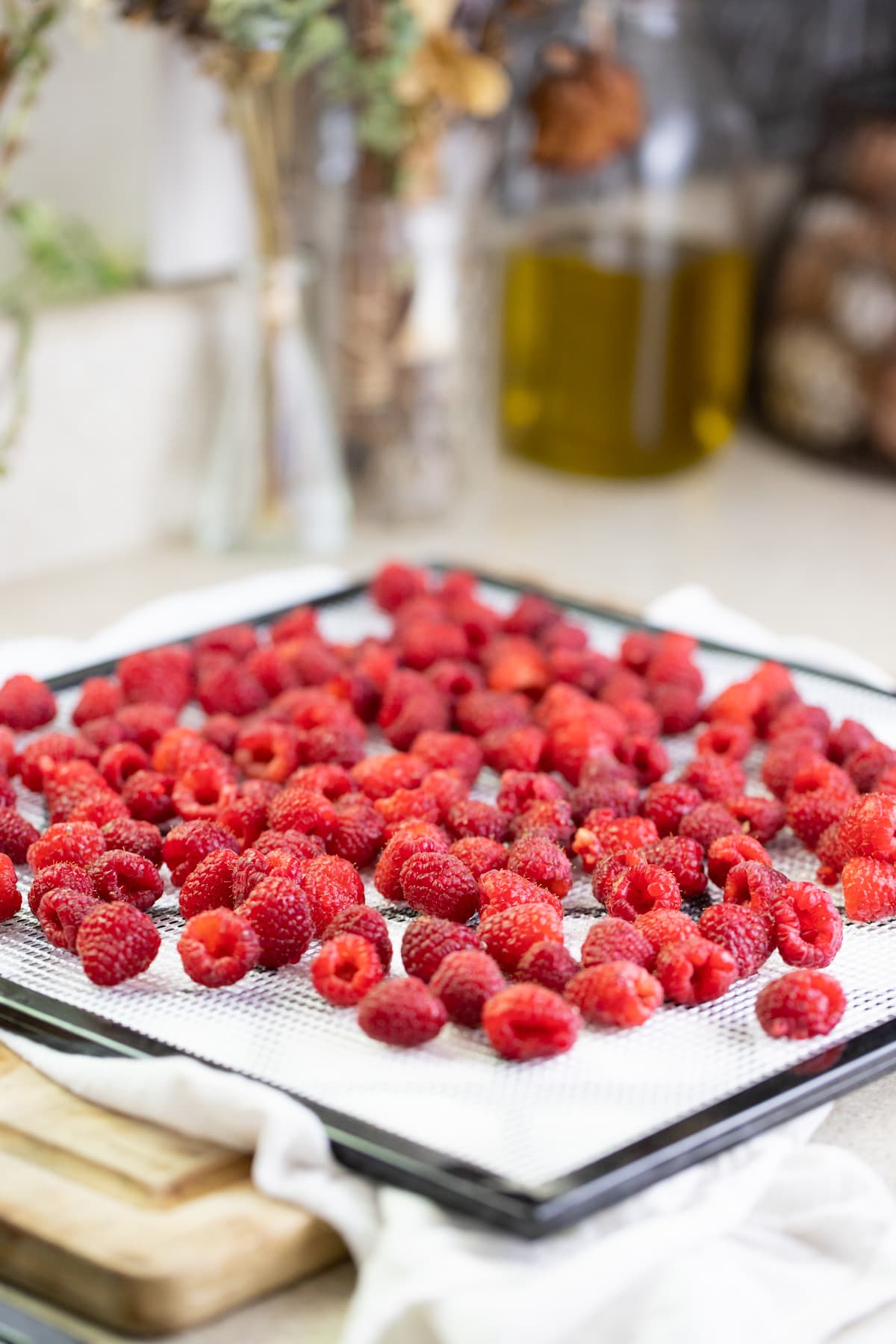
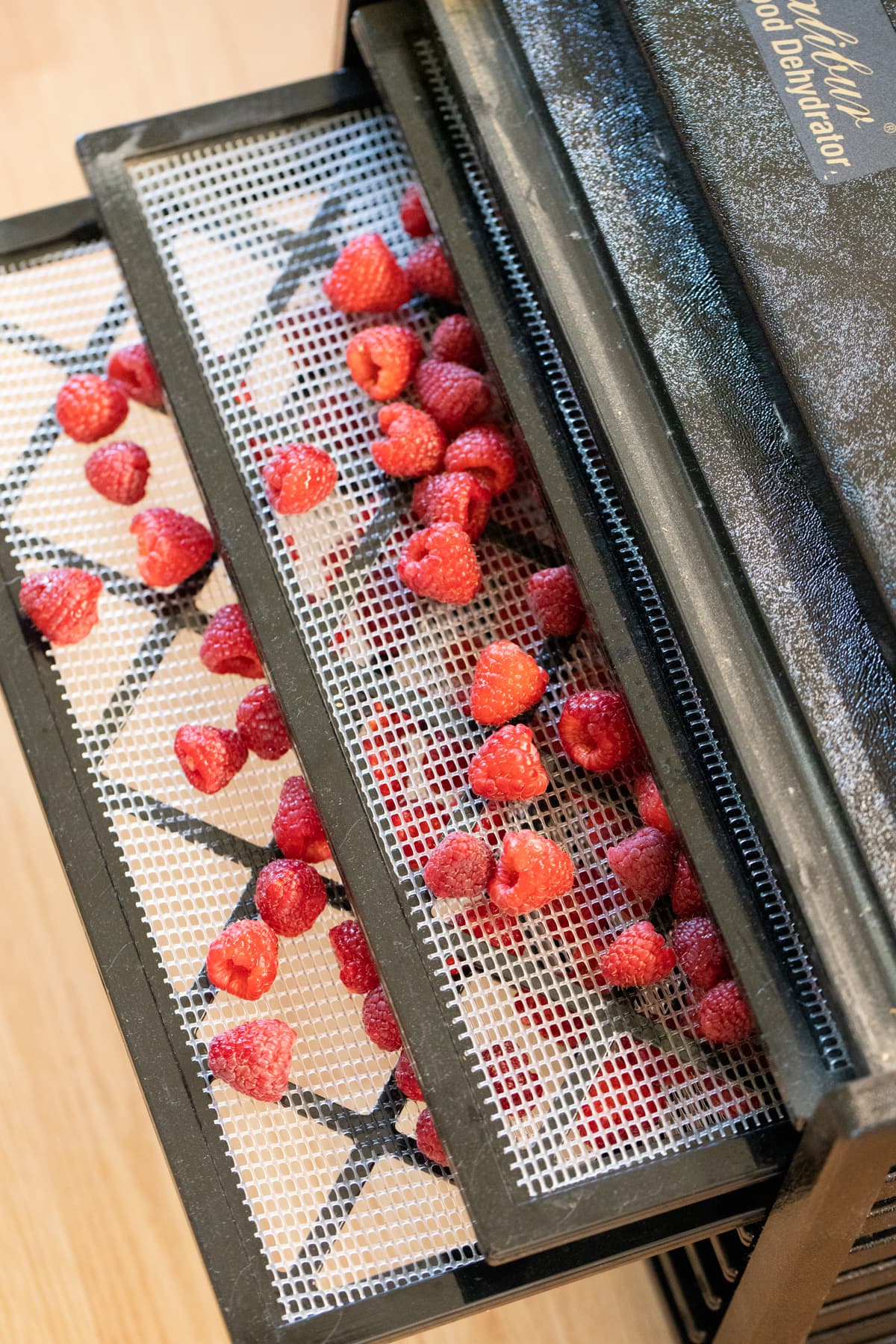
Step two – add to the dehydrator. Place the raspberries in one layer on the trays of the dehydrator, then add the trays to the dehydrator.

Step three – dehydrate. Place the trays in the dehydrator and dehydrate at 125 degrees Fahrenheit for 12-16 hours. At about 12 hours start checking your raspberries. If they are completely dry and crispy (break easily) remove them from the dehydrator. If they aren’t yet completely dry leave them for another hour or so and check again.
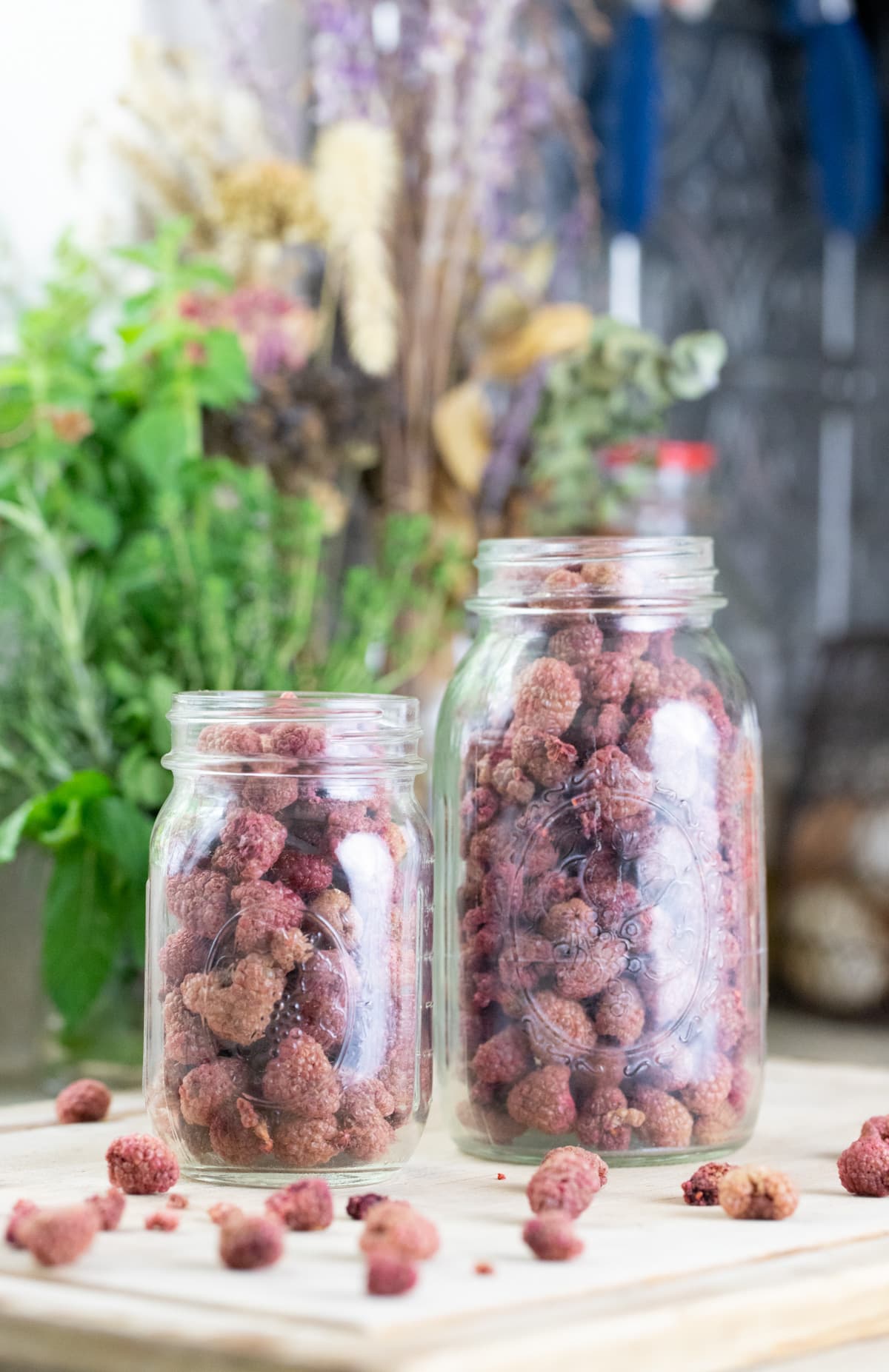
How to Store…
Once the berries are dry, let them cool for a few minutes and then transfer them to an air-tight container. You can vacuum seal them or use zip-lock bags, however, in my opinion, jars with two-piece lids work best for storage and are beautiful on the shelf!
How to Condition Dehydrated Fruit…
If you are going to store your dehydrated raspberries for the long term, make sure to condition the fruit. This means that after storage, every day for about a week, check to make sure that there is no moisture on the inside of your air-tight container. If you spot moisture, remove the fruit and dehydrate it again for a few more hours. Then transfer to an air-tight container and condition again. If after a week there is no moisture your fruit is ok to be stored for the long term at room temperature.
How to Use Dehydrated Raspberries…
- As a snack – dehydrated raspberries are an easy snack to pack the kids for a school lunch or for any other occasion. They are a great snack for a road trip or a picnic or just to pick up in the middle of the day.
- Breakfast – they are a great addition to yogurt with homemade granola or to add to any bowl of cereal.
- In baked goods – you can substitute dry raspberries for fresh ones in homemade berry bread or any other baked goods.
- Top a salad – they are a great topping! You can crush them into smaller pieces and add them to a kale salad or any other, just as you would add nuts.
- Add to shakes and smoothies – throw some dry raspberries with bananas or other fruit, milk, ice, and anything else you like into the blender and blend into a healthy drink.
How to Make and Use Raspberry Powder…
One of the greatest things about dehydrated food is that you can turn it into a powder. To make raspberry powder, place the dry raspberries in a coffee grinder and grind them until you get a powder. Store your powder in jars at room temperature. Here are a few ideas for using raspberry powder…
- Add to frosting – add the powder to a cream cheese frosting to turn it into a raspberry frosting to top any cupcake or cake.
- Add to a protein shake – if you drink protein shakes, add a tablespoon or two of raspberry powder into your shake to make it even healthier.
- Add to smoothies or milkshakes – the same way you would use it in protein shakes.
- Add to cake batter – add a few tablespoons of raspberry powder into any cupcake or cake batter whenever berry flavors fit well.
- Add it to homemade ice cream – if you like making ice cream at home you can definitely use your powder for added raspberry flavor.
- Add it to whipped cream – making whipped cream to go over a cake or maybe even your morning cupcakes? Add raspberry powder to the cream before you whip it!
Frequently Asked Questions…
Yes. Drying foods in a proper dehydrator where you can control the temperature produces a better result and preserves the nutrition better, however, if you don’t have a dehydrator, you can follow the same prep instructions: line a baking sheet with parchment paper, turn your oven to its lowest temperature (hopefully below 200 degrees Fahrenheit), and dehydrate your raspberries this way. Of course, drying time will change so keep checking your fruit. Also, you might need to turn your baking sheet and/or turn the berries halfway through.
I usually don’t feel the need to add a thing, however, you can try sprinkling some cinnamon or nutmeg on the berries or even sugar before you place them in the dehydrator.
The cheaper Presto dehydrator is very popular and you can find it at any Walmart or online. It runs at a temperature of 165 degrees Fahrenheit and there is no way to control the temperature. Yes, you can use this kind of dehydrator to dry raspberries. Again, for best results, we want to process fruit at a temperature of 125 degrees Fahrenheit but a higher temperature will work as well. Drying time will probably be shorter, around 10-12 hours or so.
Not really… Raspberries don’t rehydrate very well. Once you have dehydrated them they should be used dry.
Yes, you can! Let them thaw in a colander, set on the trays of the dehydrator, and dehydrate at 125 degrees Fahrenheit until dry. It might be a squishy mess, but it’s possible.
Dehydrating raspberries is very easy. There is pretty much no prep, the dehydrator does all the work. They are a great snack and a great ingredient to have on the shelf. I hope that this was a helpful tutorial!
More Dehydrating Tutorials…
- How to Dehydrate Strawberries
- How to Dehydrate Watermelon
- How to Dehydrate Pineapple
- How to Dehydrate Bananas
- Dehydrated Orange Slices
- How to Dry Apples in the Oven

Dehydrating Raspberries
These dehydrated raspberries are easy, healthy, and delicious. Dehydrating raspberries is also a great way to preserve them!
Ingredients
- 54 oz of raspberries (I used 54 oz but you can dehydrate as many berries as you'd like)
- Optional: sugar, cinnamon, or other seasonings (more in the notes below)
Instructions
- Remove moldy or rotten raspberries. If you need to, place the raspberries in a colander and wash the fruit. Let the berries dry for a few minutes. You can also place them on a kitchen towel and pat them dry.
- Place the raspberries in one layer on the trays of the dehydrator, then add the trays to the dehydrator.
- Place the trays in the dehydrator and dehydrate at 125 degrees Fahrenheit for 12-16 hours. At about 12 hours start checking your raspberries. If they are completely dry and crispy (break easily) remove them from the dehydrator. If they aren’t yet completely dry leave them for another hour or so and check again. Depending on the size and juiciness of your raspberries, you might need to keep them in the dehydrator for 14 or ever 16 hours.
- Once the berries are dry, let them cool for a few minutes and then transfer them to an air-tight container. You can vacuum seal them or use zip-lock bags, however, in my opinion, jars with two-piece lids work best for storage and are beautiful on the shelf.
- If you are going to store your dehydrated raspberries for the long term, make sure to condition the fruit. This means that after storage, every day for about a week, check to make sure that there is no moisture on the inside of your air-tight container. If you spot moisture, remove the fruit and dehydrate it again for a few more hours. Then transfer to an air-tight container and condition again. If after a week there is no moisture your fruit is ok to be stored for the long term at room temperature.
Notes
Frequently Asked Questions...
- Can I dehydrate raspberries in the oven?
Yes. Drying foods in a proper dehydrator where you can control the temperature produces a better result and preserves the nutrition better, however, if you don’t have a dehydrator, you can follow the same prep instructions: line a baking sheet with parchment paper, turn your oven to its lowest temperature (hopefully below 200 degrees Fahrenheit), and dehydrate your raspberries this way. Of course, drying time will change so keep checking your fruit. Also, you might need to turn your baking sheet and/or turn the berries halfway through. - Can I add seasoning to my raspberries?
I usually don’t feel the need to add a thing, however, you can try sprinkling some cinnamon or nutmeg on the berries or even sugar before you place them in the dehydrator. - I can’t control the temperature on my dehydrator, can I still use it?
The cheaper Presto dehydrator is very popular and you can find it at any Walmart or online. It runs at a temperature of 165 degrees Fahrenheit and there is no way to control the temperature. Yes, you can use this kind of dehydrator to dry raspberries. Again, for best results, we want to process fruit at a temperature of 125 degrees Fahrenheit but a higher temperature will work as well. Drying time will probably be shorter, around 10-12 hours or so. - Can I rehydrate raspberries?
Not really… Raspberries don’t rehydrate very well. Once you have dehydrated them they should be used dry. - Can I dehydrate frozen raspberries?
Yes, you can! Let them thaw in a colander, set on the trays of the dehydrator, and dehydrate at 125 degrees Fahrenheit until dry. It might be a squishy mess, but it’s possible.
Nutrition Information:
Yield: 1 Serving Size: 1Amount Per Serving: Calories: 100Total Fat: 10gSaturated Fat: 0gTrans Fat: 0gUnsaturated Fat: 7gCholesterol: 0mgSodium: 16mgCarbohydrates: 189gFiber: 101gSugar: 72gProtein: 18g


